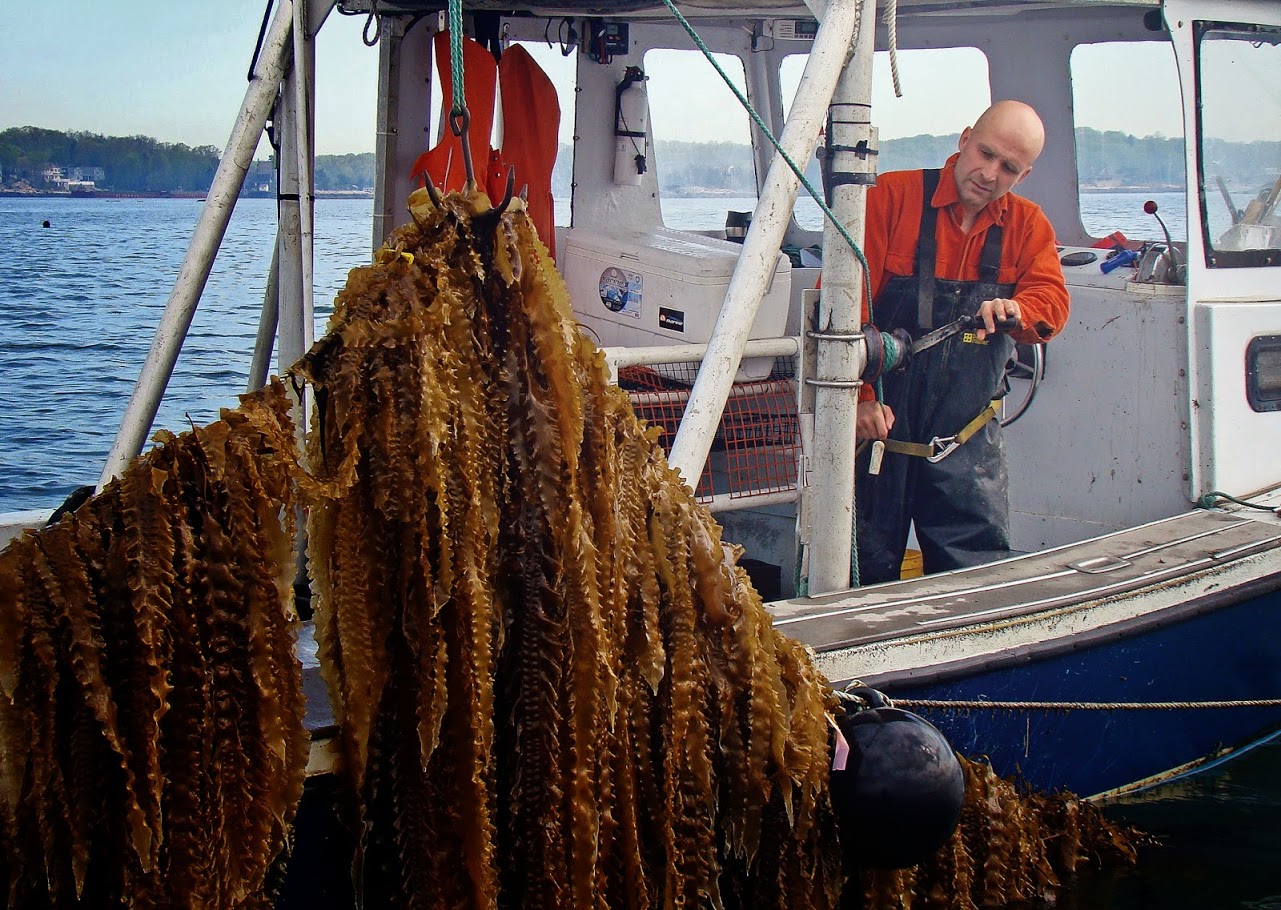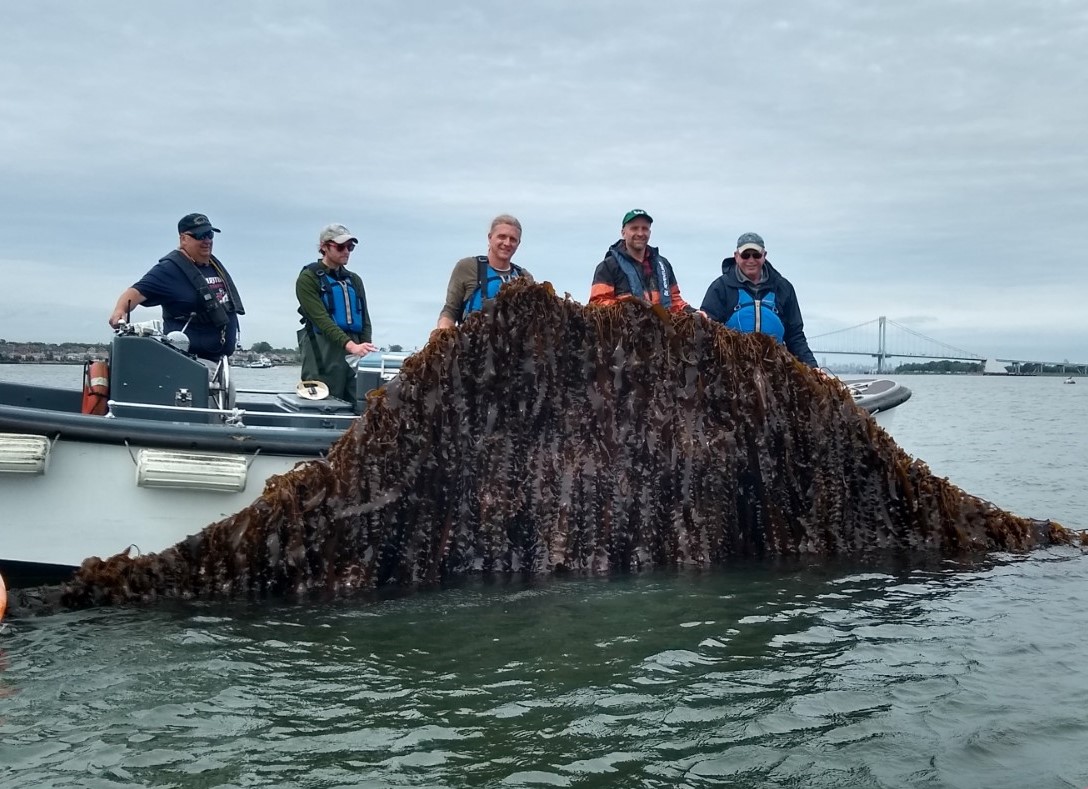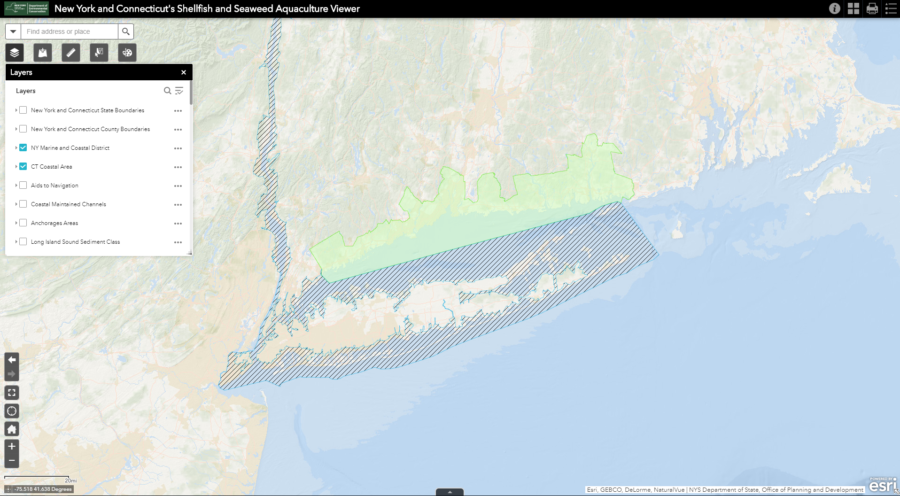Nutrient Bioextraction: Extracting Pollution from the Sound
Nutrient Bioextraction combines growing and harvesting shellfish and seaweed for the purpose of removing nitrogen and other nutrients from coastal waters.
Nutrient Bioextraction combines growing and harvesting shellfish and seaweed for the purpose of removing nitrogen and other nutrients from coastal waters. Nutrient bioextraction can also provide economic benefits. Since 2009, the Long Island Sound Study has promoted efforts to bring nutrient bioextraction to Long Island Sound. In 2018, the New York State Department of Environmental Conservation and NEIWPCC with support from LISS hired a bioextraction coordinator to implement a Bioextraction Initiative.
Bren Smith harvests sugar kelp in his seaweed/oyster farm off the Thimble Islands in Branford. Smith started seaweed farming as a result of research being conducted by scientists in the Sound. Photo by Ron Gatreau.

What is the Role of the Nutrient Bioextraction Initiative?
The Initiative provides information to decision-makers to help them develop guidelines needed to facilitate public and private seaweed and shellfish farming and harvest operations in their coastal waters (see Nutrient Bioextraction Initiative fact sheet). The project is managed by the New England Interstate Water Pollution Control Commission, in collaboration with the New York State Department of Environmental Conservation and the Long Island Regional Planning Council, with funding from the Long Island Sound Study.
Why is Nutrient Bioextraction Being Considered for Long Island Sound?
Reducing nutrient inputs is a priority for many estuary programs in the United States, including Long Island Sound, Chesapeake Bay, and the Gulf of Mexico. By reducing nutrients in coastal waters, states and federal agencies hope to reduce widespread and recurring problems with algal blooms, loss of seagrass, and hypoxia (low dissolved oxygen). Nutrient bioextraction can complement existing programs (such as using advanced treatment methods to remove nitrogen from wastewater treatment plant sewage discharges into the Sound). It is the only method available to remove nitrogen after it has entered the Sound.
What is Being Done to Advance Bioextraction in Long Island Sound and the East Coast?
Virtual Long Island Sound Seaweed Symposium
The Long Island Sound Seaweed Bioextraction Symposium, held virtually over two days from May 18-19, 2022, brought together speakers and participants to discuss opportunities and challenges for a bioextraction industry within Long Island Sound. Recordings of the symposium are available online. Learn more.
NEW YORK AND cONNECTICUT’s Shellfish and seaweed AQUACULTURE VIEWER
The New York and Connecticut Shellfish and Seaweed Aquaculture Viewer is an online ArcGIS map that provides spatial information for all of New York’s Marine and Coastal District and Connecticut’s Coastal Area to aid in identifying potential locations for commercial shellfish and seaweed aquaculture and nutrient bioextraction operations. Learn more.
Interactive table and map of Long island Sound bioextraction projects
Find where LISS funded bioextraction projects since 2011. Learn more.
Practical Government and Private Sector Applications of Bioextraction
Nutrient bioextraction projects taking place in Long Island Sound and elsewhere along the East Coast provide case studies of practical government and private sector applications. Learn more.
Ribbed Mussel and seaweed Pilot Studies

Bioextraction projects started by the Long Island Sound Study and its partners nearly over a decade ago off Hunts Point in the South Bronx and in two sites in Connecticut have initiated interest in testing for the effectiveness of ribbed mussels and seaweed in removing nitrogen from the local environment. Learn more.
Ecosystem Services Assessment of Bioextraction in Long Island Sound
Ecological, economic, and other models in a research project show that oyster aquaculture in Long Island Sound compared favorably to existing nutrient reduction methods, in terms of both the cost and effectiveness of nitrogen removal. Oyster aquaculture has the added benefit of providing a sustainable source of local seafood. Learn more.
Contact
For more information about the Nutrient Bioextraction Initiative, contact the New York State Department of Environmental Conservation, Division of Water, at LIwaterquality@dec.ny.gov.



